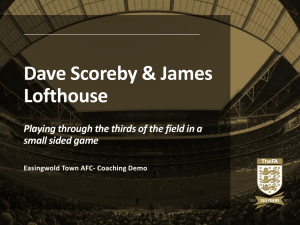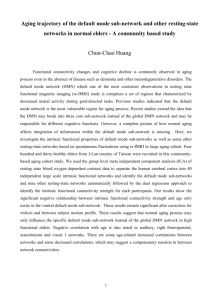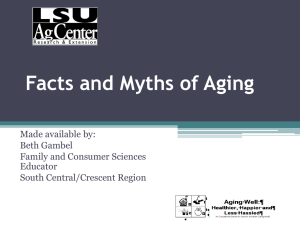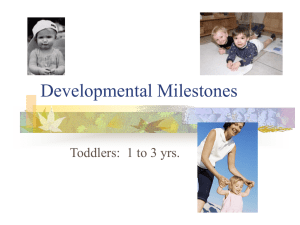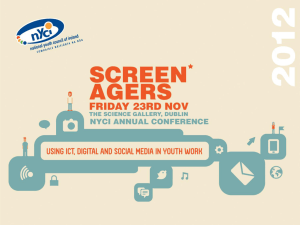Brain Plasticity in Aging - The MacArthur Foundation Research
advertisement
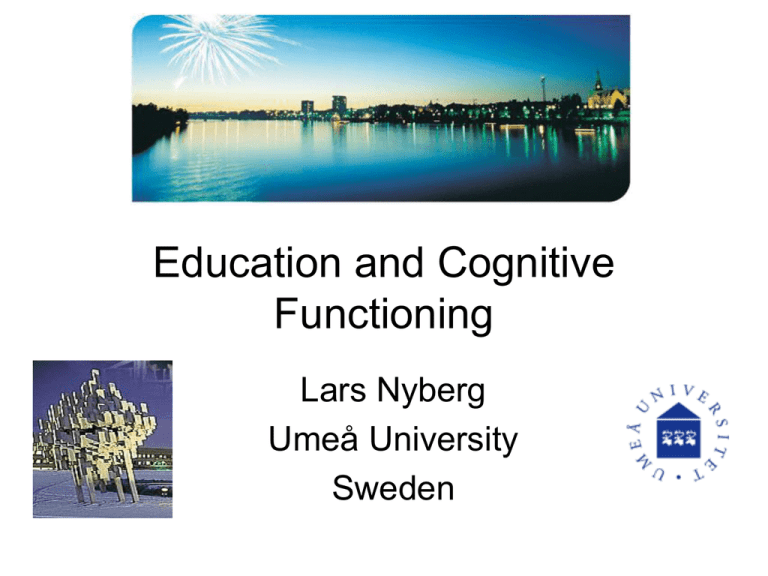
Education and Cognitive Functioning Lars Nyberg Umeå University Sweden Research on Aging at UmU • Cross-faculty environment ”Aging and Living Conditions” (ALC) • One of 10 national ”Linnaeus” centra funded by the Swedish Research Council • Three main themes: Ageing population •Fertility •Mortality •Migration •Biological ageing Participation Interdisciplinary research Linnaeus database Conceptual development Successful ageing •Health •Cognition •Economy •Network •Care •Work •Leisure •Social relations •Society •Image of ageing The Linnaeus Database Statistics Sweden register data Inpatient and death cause data VIP Västerbotten county Betula Umeå Geographical extension Sweden Sweden Västerbotten county Umeå Number of individuals Total national population Total national population 110 000 4200 Time coverage 1960 – 1990 1990 - 2005 1980s - 2006 1987, 19.. 1988, 19.. Time resolution 5 year (60 -90) Annual (90-05) Continuous Spatial resolution 100 meter squares Kind of information Socio-economic Income Family (links) Work Residence etc. Hospital care Death Death cause 5 year Health indicators Life style Living conditions Socio-economic Cognitive function Health Socioeconomic The Betula Study: A prospective study of aging, memory & health Sample Wave 1 (1988-90) Wave 2 (1993-95) Wave 3 (1998-00) Wave 4 (2003-05) 1 N=1000 35-80 yrs N=862 (86%) 40-85 yrs N=730 (85%) 45-90 yrs 609 (83%) 50-95 yrs 2 N=1000 35-80 yrs N=684 (86%) 50-85 yrs 3 N=1000 40-85 yrs N=829 (83%) 45-90 yrs 4 698 (84%) 50-95 yrs N=600 35-90 yrs Total of > 4200 participants S5: 563 35-95 yrs Two sessions 1. Health examination - current & past health - demographics - subjective measures - social variables - critical life events - personality - genetics (APOE, COMT) 2. Cognitive testing Cross-sectional analyses N = 1959 • Episodic: significant decline already at age 45 • Semantic memory: significant decline after 55 Rönnlund et al (2005) Psych & Aging Longitudinal analyses Practice-adjusted data* • Episodic: significant decline at age 80 • Semantic : significant decline at age 85 • Episodic: significant decline at age 65 • Semantic : significant decline at age 80 *P= D-A Difference (D) = S1T2 – S2T2 = Attrition (A) + Practice (P) A = S1T1 (returnees) – S1T1 (whole group); Comparing longitudinal and cross-sectional data Cross-sectional data ≠ Practice-adjusted longitudinal data Influence of cohort differences in education on cross-sectional data? Education Self-reported # years of formal education Education-adjusted crosssectional data Identical pattern as practice-adjusted longitudinal data (significant decline in episodic memory 60-65 yrs) Intermediate summary Cohort differences in education account for disparity between cross-sectional and longitudinal trajectories across the adult age span -- control removes early onset of episodic decline (35-60) Substantial portion of the age-related variance remained after controlling for education in the 5 oldest cohorts Variability in cognitive aging Most studies consider group-averaged cognitive changes -- less focus on distribution of individual scores => => Some elderly with a high level of functioning are ”hidden” Inspired by Rowe and Kahn (1987) we used Q-mode factor analysis to identify usual and successful aging on basis of longitudinal change in performance across cognitive and non-cognitive variables (Habib, Nyberg & Nilsson, 2007). --usual vs successful: based on performance levels at two test sessions and change in levels across sessions Sample composition Middle age = 50-65 at T1; 55-70 at T2 Measures Results 55 / 663 successful (8.3%) 25 / 403 successful (6.2%) Variables defining usual vs.successful aging Longitudinal analysis 51 of the 55 successful elderly at T1 were re-tested at T2 Of these 51, 18 (35%) were again classified as successful 352 of the 608 usual elderly at T1 were re-tested at T2 Of these 352, 345 (98%) were again classified as usual -- 7 (2%) were classified as successful (”positive reversal”) Predictors of success over time: Successful-Successful (N=18) vs Successful-Usual (N=33) • no difference on cognitive measures • one difference on non-cognitive measures; education (12.1 vs 9.6 years) Neural correlates of success over time (Persson et al., 2006, Cerebral Cortex) Participants from the Betula Study (selected from population of 1000 ss at T1) ’Memory’ defined by 3 episodic tests Stable & Decline groups well matched (N=20/20): • Age: 68.2 / 68.2 • MMSE: 28.25 / 28.35 • Female/male: 13/7 / 13/7 • Education: 10.1 / 10.7 2002-03: MRI/fMRI-session fMRI – categorization task (abs/conc) - left PFC activity for young adults (Wagner et al. 2000, Cer Cortex) • Hippocampus volume • Diffusion Tensor Imaging (DTI) Group differences: brain structure Hippocampal volume Anterior white matter integrity Functional changes Categorization vs Rest Overall analysis (N=40) revealed bilateral frontal activity Both groups showed typical left PFC activity Atypical right frontal activity driven by declining elderly -- compensatory response? Fostering positive reversals: Cognitive training ”Spontaneous” positive reversals rare (2%) => directed training Several recent demonstrations that training can improve performance on various executive tasks (e.g. working memory) - transfer / generalization of learning more difficult to show Present study: updating training (Dahlin et al., 2008, Science; Dahlin et al., 2009, Psychology & Aging) Training of updating FMRI I LM n-back Stroop L WEEK 1 WEEK 2 WEEK 3 WEEK 4 WEEK 5 Time FMRI II LM n-back Stroop 3 V M 1 4 Always memorize last 4 items Variable list length — 5-15 items Also ”keep track” task Graded training (3 levels; all at level 3 at week 5) Younger (15) and older adults in training group Control group did fMRI I & II Extensive transfer battery outside scanning 18-month maintenance test session Behavioral findings: criterion task Substantial training effect in both groups Significant long-term maintenance Transfer Speed Working memory Episodic memory Semantic memory Reasoning -letter fluence (FAS) -Raven’s -digit symbol -computation span -recall of nouns -digit span (F/B) -paired associates -category fluency -n-back (1/2/3) Limited transfer effects -no significant transfer for elderly group -significant transfer to 3-back working memory of numbers for young (transfer effect maintained after 18 months) FMRI findings: young adults Pre-training -- fronto-parietal activity for all 3 tasks -- striatal activity for LM & 3-back Training-related changes --no common fronto-parietal changes --overlapping increase in striatum for LM & 3-back (No significant training-related fMRI changes on Stroop) FMRI findings: older adults • Pronounced fronto-parietal activity during LM prior to training • No significant striatal activation during LM prior to training • Training-related striatal increase for LM (cf., younger adults) • No training-related increase for 3-back Variability within older group – those who showed transfer displayed striatal activation Summary • Substantial and durable training effects in both groups – Weak transfer effects • More narrow view on process-region overlap – No support that a task-general fronto-parietal system mediates transfer – Support that transfer rests on shared process (updating) and related striatal brain system Concluding points • Education – substantial influence on ”cognitive profile” across the adult life span – Strong impact on slope for younger cohorts • Education also explains some of the heterogeneity among older adults • Neural changes additional factor – Hippocampus & striatum; ant. WM changes • Functional compensation? • Next step: Imaging at Betula T5 – Brain x education interactions?

